
Iceplant (Mezembriantemum), Patagonia, Argentina
Deserts
Most visitors come to deserts to see large and impressive things,
like canyons, sand dunes or flower displays. This page is mostly devoted to small
things, although it also contains some flower-covered plains and canyons. Desert
photography is relatively easy, because you seldom have to worry about weather
or about utility poles in the background. Just take your camera and look around.

Asian glass lizard
(Ophisaurus apodus),
Shirvan, Azerbaijan |
Deserts are the last places
on Earth where reptiles still rule. You can travel around the world's deserts
doing nothing but looking on their faces - and you'll never be bored. This large
legless lizard is widespread in Western Asia, its Russian name is zheltopuzik
- "yellow tummy". |
| This tiny lizard is the
most abundant vertebrate species of Mongolian deserts.
In areas with different soil color it can be yellow, grey, black or pink. Dark-purple
specimens from black obsidian lava fields are the most beautiful ones. It is active
even during the hottest part of the day. |
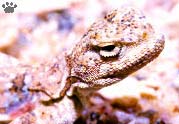
Phrynocephalus versicolor,
Transaltai Gobi, Mongolia |
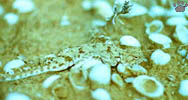
Phrynocephalus helioscopus,
Aral Sea, Uzbekistan |
More than 30 species of this genus inhabit deserts
of Africa and Asia, from Sahara to Tibet, as well as the dry bottom of almost
extinct Aral Sea. Their name in Karakalpak language means "the tip of your
shadow" - they sometimes run for few minutes in front of you, keeping distance
of 1-2 m (3-7'). |

Phrynocephalus auritus,
Repetek, Turkmenistan |
The largest of Phrynocephalus
lizards has red "ears" to impress its potential enemies. If the display
doesn't work, the lizard can disappear in the sand in few seconds. |

Phrynocephalus auritus,
Repetek, Turkmenistan |
| This species is the smallest one, only 5 cm (2")
long, including tail. It inhabits sandy deserts and has a lifespan of only one
year. Some Phrynocephalus lizards can be found above 4500 m (15,000') in
Tibet - higher than any other reptile. At this altitude,
they are active for only 4-5 hours a day, and only 4-6 weeks a year. |

Phrynocephalus guttatus,
Uzboi, Turkmenistan |
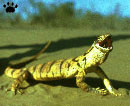
Desert monitor,
Repetek, Turkmenistan |
The largest lizard of Asian deserts is desert monitor
(Varanus griseus). It feeds on rodents, snakes, bird eggs and chicks, and
young tortoises. Monitors are smart lizards, and they can kill all gerbils in
a large colony within a few days. Sometimes gerbils leave the colony altogether
if a monitor enters the burrow system. |

Agama pallidus,
Merv, Turkmenistan |
Some desert lizards spend their entire
life inside small bushes. In Karakum Desert, agamas and geckos are the most common
bush residents. They are difficult to find, even if a bush is only few inches
tall. |

Gymnodactilys caspius,
Tudym, Turkmenistan |
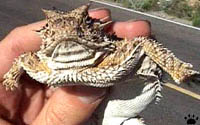 |
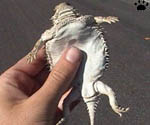 |
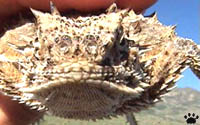 |
| Ph. cornutum, Dripping Springs,
New Mexico. |
| The most bizarre lizards of North American deserts
are "horned toads" (Phrynosoma). Once abundant, they are now
rare and very local because of illegal pet trade, habitat loss, pesticide poisoning,
and because their prey, large ants, is replaced by introduced Argentina fire ants
(Solenopsis invicta). Their dependence on large ants also means that they
are very difficult to feed in captivity. Of the thousands sold as pets, almost
all die within few months. |
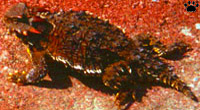
Ph. coronatum, Mt. Diablo, California. |
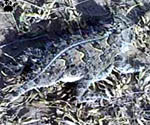 |
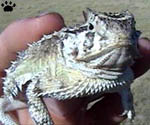 |
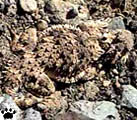 |
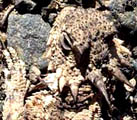 |
| Ph. cornutum, Comanche Nat'l
Grassland, Colorado. |
Ph. platyrhinos, El Pinacate
Nat'l Park, Sonora. |
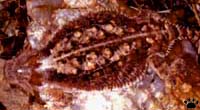
Ph. solare, Tucson, Arizona. |
These cute and intelligent creatures are known for
a number of unique traits, such as their ability to spurt blood from their eyes
to repel predators. Interestingly, they are an almost exact (although not life-size)
copy of some extinct reptiles, such as a giant Permian herbivore called Pareiasaurus. |
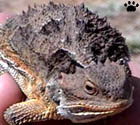 |
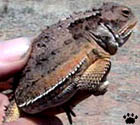 |
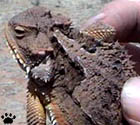 |
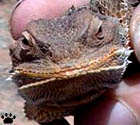 |
| Ph. douglassii, Zuni, New
Mexico. |
| This small snake of Asian deserts lives in bushes,
hunting for lizards. It is harmless, but so fast that local Kazakh people believe
it can kill a man or a camel by jumping through it. Its local name is "arrow
snake". |

Psammophis lineolatus, Repetek, Turkmenistan. |
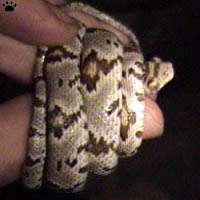 |
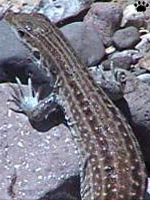 |
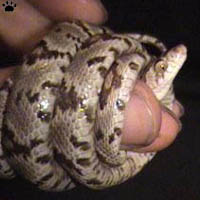 |
| Lyre snake (Trimorphodon biscutatus)
and Gila spotted whiptail (Cnemidophorus flagellicaudus), Peloncillo Mts.,
New Mexico. |
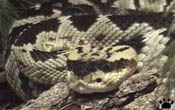
Black-tailed rattlesnake (Crotalus
molossus), Carlsbad, New Mexico. |
Snakes are common in many deserts,
but they can be difficult to find. They often show up for only a few hours a day,
when the temperature is the most comfortable. Some snakes spend their entire life
underground. |
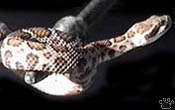
Mojave rattlesnake (C. scutulatus),
Carlsbad, New Mexico. |
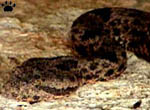 |
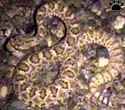 |
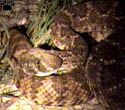 |
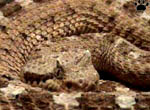 |
| Rattlesnakes of North America,
left to right: rock rattlesnake (C. lepidus), massassauga (Sisturus
catenatus), western diamondback (Hylactophryne augusti), sidewinder
(C. cerastes). . |

Agkistrodon pallasii,
Agadyr, Kazakhstan. |
Snakes of viper family normally hunt rodents and other
small warm-blooded animals, but in deserts many of them prefer lizards, such as
this pit viper from Betpak-Dala Desert. In some years, they don't have enough
lizards to eat, so they switch to locusts and jerboas. Ili River valley in Kazakhstan
once had the world's highest density of poisonous snakes - up to 100,000 vipers
and pit vipers per square kilometer. |
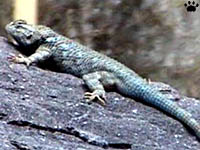 |
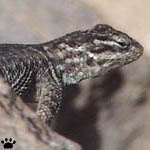 |
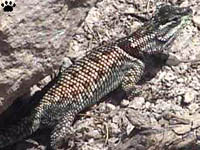 |
| Spiny lizards (Scleroporus)
are very common in North American deserts. Left to right: desert (S. magister),
Clark (S. clarkii) and mountain (S. jarrovii) spiny lizards, New
Mexico. |
| Some places are not normally thought of as deserts,
but deserts they are, like most of Galapagos Islands. Naturally, they are also
ruled by reptiles, mostly giant tortoises. Here you also find lizards, but some
of them dive in the ocean for food! There are also small, less-known reptiles
on Galapagos - lizards and non-poisonous snakes. |

Marine Iguana (Amblyrhynchus
cristatus), Islas Galapagos. |
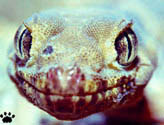
Teratoscincus przhevalskii,
Transaltai Gobi, Mongolia. |
Many of the most interesting
lizards emerge at night. This is a rare gecko from southern Mongolia and adjacent
China. It prefers areas with soft soil, and spends ten months a year underground,
because it is active only in warm nights which are rare in Gobi
Desert. |
| In sandy deserts of western Central Asia and Middle
East, it is replaced by more common relative. To find this lizard, point your
flashlight on sandy dunes late at night. White eyes you'll see belong to wolf
spiders, red ones to geckos. |
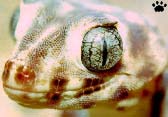
Teratoscincus scincus,
Repetek, Turkmenistan |
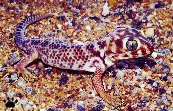
Gecko in search of prey,
Repetek, Turkmenistan |
These lizards are very delicate. If you hold them
in a wrong way, they easily drop their tails and large pieces of skin. The tail
immediately starts moving, producing loud noise with large scales on its upper
side. |
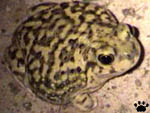 |
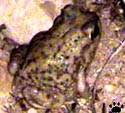 |
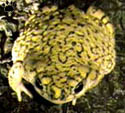 |
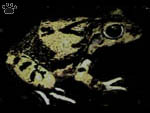 |
| Some deserts have surprising variety
of amphibians. Common species of Chihuahua Desert, left to right: Couch spadefoot
(Scaphiopus couchii), female and male; Chihuahuan gren toad (Bufo debilis),
barking frog (Hylactophryne augusti). Nacori Chico, Sonora, Mexico. |
| Most desert mammals are also nocturnal, especially
carnivores, such as this hyena or wild cats.
To see them, you have to hike for miles across the desert, searching with your
flashlight for light-reflecting eyes. Sandy deserts are usually better than clay-
or stones-covered. |

Striped Hyena (Hyaena
hyaena), Arava, Israel |
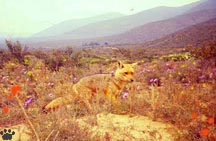
Culpeo Fox (Dusicuon culpaeus), Fray Jorje, Chile. |
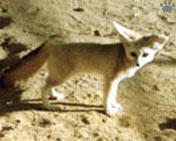
Fennek fox (Vulpes zerda), Nizzana, Israel. |
In cold months, or after rains, carnivores can also
appear at daytime, lured by abundant food: birds' nests, large insects, or frogs. |
| Rodents are usually more easy to see, although some
species - pigmy jerboas, kangaroo mice - are so shy that they emerge only in moonless
nights. You can find them by sound or wait for them near burrows. |

Hamster Phodopus campbelli,
Hovd, Mongolia |
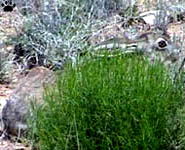 |
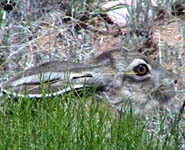 |
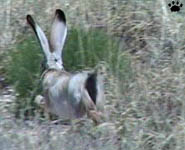 |
| Black-tailed jackrabbit (Lepus
californicus), Sevilleta NWR, New Mexico. |
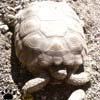
Desert Tortoise
(Gopherus agassizii),
Mojave Desert, California |
Being able to dig yourself a burrow is critical for
desert survival. Burrow is not only a shelter from predators and extreme temperatures,
it can be a comfortable place to live in. Some of the best builders can make so
nice burrows, that many other species come to join them. Desert tortoises spend
up to 10 months a year in their burrows, together with many reptiles, insects
and other tenants. |
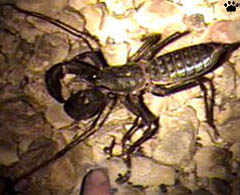
Giant vinegaroon (Mastigoproctus giganteus),
Sitting Bull Falls, New Mexico. |
Some desert creatures look a bit scary, but are harmless (like
the one to the left), or peaceful unless provoked, like the one to the right. |
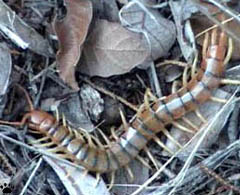
Red-headed centipede (Scolopendra heros),
Peloncillo Mountains, New Mexico. |
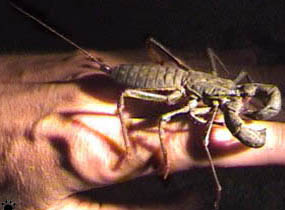
|
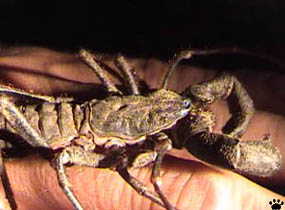 |
| Giant vinegaroons grow up to 12 cm/5'.
They can pinch you really hard, and spray vinegar acid from their "tails", but
are not poisonous or aggressive. Water Canyon, New Mexico. |

Karakurt (Latrodectes
tridecimpunctatus),
Agadyr, Kazakhstan |
Spiders and scorpions are common in
deserts, but usually you have to look for them to see any. Karakurt (left), the
Asian relative of "black widow" of North America, is much feared - people
die sometimes if being bitten by a female. Injected venom can be destroyed if
you press a burning match to a bite within a minute from being bitten. Tarantulas
look much more scary, but they are not dangerous. |

Desert tarantula
(Lycosa karakumensis),
Bahardok, Turkmenistan |
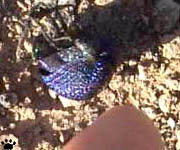 |
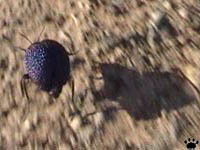 |
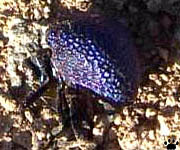 |
| Fast-running blister beetles of
genus Cysteodemus are protected from scorching desert sun by a layer of
air under their inflated elaters. They look like rolling bubbles. Three Rivers,
New Mexico. |
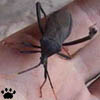
Leaf-footed bug
(Leptoglossus), White
Sands, New Mexico. |
Insects are present even in the driest
deserts, but most are nocturnal. Only various flies and darkling beetles are usually
easy to find during the day. Eleodes beetles (right) are particularly common
in many deserts and grasslands of the Northern hemisphere. |
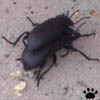
Darkling beetles
(Eleodes), Sevilleta
NWR, New Mexico. |
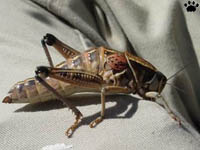 |
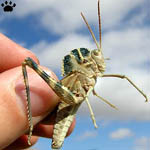 |
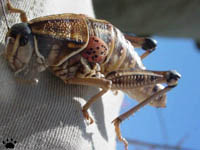 |
| Assorted grasshoppers, Sevilleta National Wildlife Refuge, New Mexico. |
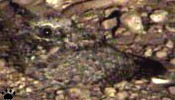
Poorwill (Phalaenoptilus nuttallii), Sonora.
Part 2
Home
|



































































